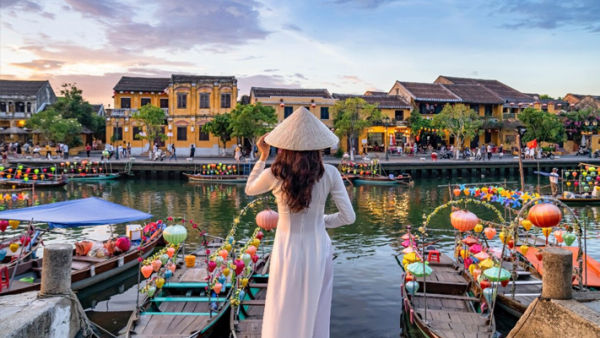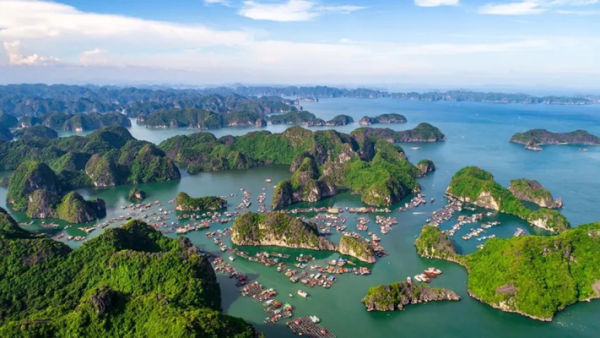HOW TO MAKE THE BEST OF YOUR VIETNAM TRIP – A JOURNEY OF FLAVOURS, COLOURS AND CAPTIVATING EXPERIENCES

Vietnam, a captivating country in Southeast Asia, is a land of captivating beauty, rich history, and vibrant culture. From its bustling cities to its breathtaking natural landscapes, Vietnam offers a unique blend of traditional charm and modern excitement. With its picturesque rice terraces, magnificent karst formations, vibrant markets, and mouthwatering cuisine, Vietnam has something to offer every traveler. Immerse yourself in the bustling streets of Hanoi, cruise through the iconic Ha Long Bay, explore the ancient town of Hoi An, or relax on the pristine beaches of Phu Quoc. Whether you're seeking cultural experiences, outdoor adventures, or culinary delights, Vietnam is sure to captivate your senses and leave you with lifelong memories.


How to Make The Best of Your Trip
To make the best of your Vietnam trip, here are some tips and recommendations:
Plan Your Itinerary: Vietnam is a diverse country with numerous attractions. Research and plan your itinerary based on your interests and the duration of your trip. Consider visiting both the northern and southern regions to experience the variety of landscapes, cities, and cultural highlights.
Visit Major Cities: Explore the vibrant cities of Hanoi and Ho Chi Minh City (Saigon). In Hanoi, wander through the historic Old Quarter, visit iconic sites like Hoan Kiem Lake and the Temple of Literature, and savor authentic Vietnamese cuisine. In Ho Chi Minh City, explore the bustling streets, visit the War Remnants Museum, and indulge in the city's lively nightlife.
Explore Natural Landscapes: Vietnam is blessed with stunning natural landscapes. Don't miss the breathtaking beauty of Ha Long Bay, where you can cruise among the limestone karsts and enjoy activities like kayaking and cave exploration. Consider visiting other natural wonders like Sapa's rice terraces, Ninh Binh's limestone formations, or the picturesque beaches of Da Nang and Nha Trang.
Experience Local Culture: Engage with the local culture by visiting historical sites, temples, and pagodas. Explore the ancient town of Hoi An, a UNESCO World Heritage site known for its well-preserved architecture and lantern-lit streets. Take part in a cooking class, visit local markets, and learn about traditional crafts.
Try Vietnamese Cuisine: Vietnam is famous for its delicious cuisine. Sample iconic dishes like pho (noodle soup), banh mi (Vietnamese sandwich), fresh spring rolls, and local street food. Be adventurous and try regional specialties in different cities.
Go Off the Beaten Path: While popular destinations are worth visiting, consider venturing off the beaten path to discover lesser-known gems. Explore the remote landscapes of Ha Giang, trek in the mountains of Dalat, or experience the tranquility of the Mekong Delta.
Embrace Transportation Adventures: Traveling within Vietnam can be an adventure in itself. Take a cyclo ride in Hanoi's narrow streets, hop on a motorbike taxi (xe om), or enjoy a scenic train journey between cities. Embrace the local transportation options to immerse yourself in the Vietnamese way of life.
Stay Flexible and Open-Minded: Vietnam is a dynamic country with its own unique charm and challenges. Embrace the unexpected, stay flexible with your plans, and have an open mind to fully enjoy the experiences and surprises that Vietnam has to offer.
One Week Suggested Itinerary
Here's a suggested 1-week itinerary for exploring Vietnam:
Day 1: Hanoi
- Arrive in Hanoi, the capital city of Vietnam.
- Explore the historic Old Quarter, visit Hoan Kiem Lake, and enjoy the bustling atmosphere.
- Visit the Temple of Literature and learn about Vietnam's rich history.
- Sample delicious street food in Hanoi's food stalls and restaurants.
Day 2: Ha Long Bay
- Take a day trip to Ha Long Bay, a UNESCO World Heritage site known for its stunning limestone karsts and emerald waters.
- Cruise through the bay, visit caves, kayak, and enjoy a seafood lunch on board.
- Return to Hanoi in the evening.
Day 3: Hoi An
- Fly from Hanoi to Da Nang and transfer to the charming town of Hoi An.
- Explore the ancient town's well-preserved architecture, lantern-lit streets, and local markets.
- Visit the Japanese Covered Bridge, the Assembly Hall of the Fujian Chinese Congregation, and the Hoi An Museum of History and Culture.
- Enjoy a leisurely stroll along the Thu Bon River and try Hoi An's famous cao lau noodles.

Day 4: Hoi An
- Take a bicycle or motorbike ride to explore the nearby countryside and rural villages.
- Visit Tra Que Herb Village and learn about traditional Vietnamese farming practices.
- Enjoy a relaxing afternoon on An Bang Beach or Cua Dai Beach.
Day 5: Ho Chi Minh City (Saigon)
- Fly from Da Nang to Ho Chi Minh City.
- Explore the bustling streets of the city, visit the War Remnants Museum, and the historic Reunification Palace.
- Take a walking tour of the Notre-Dame Cathedral, Central Post Office, and the vibrant Ben Thanh Market.
- Experience the city's vibrant nightlife and enjoy a traditional Vietnamese dinner.
Day 6: Mekong Delta
- Take a day trip to the Mekong Delta, a fertile region known for its rivers, canals, and lush green landscapes.
- Cruise along the Mekong River, visit local villages, and experience the traditional way of life.
- Enjoy a boat ride through narrow canals and sample fresh tropical fruits.
- Return to Ho Chi Minh City in the evening.
Day 7: Cu Chi Tunnels and Departure
- Visit the Cu Chi Tunnels, an extensive network of underground tunnels used during the Vietnam War.
- Learn about the history and tactics of the Viet Cong.
- Return to Ho Chi Minh City and spend your remaining time exploring the city, shopping for souvenirs, or enjoying a relaxing coffee at a local café.
- Depart from Ho Chi Minh City.
This itinerary provides a glimpse into the highlights of Vietnam, including the bustling cities, cultural heritage sites, natural beauty, and local experiences. You can adjust the itinerary based on your interests and the time you have available, but it offers a good balance between popular destinations and off-the-beaten-path experiences.
Must Try Vietnamese Cuisine
Vietnamese cuisine is renowned for its vibrant flavors, fresh ingredients, and balance of textures. Here are some must-try dishes that represent the diversity and deliciousness of Vietnamese cuisine:
Pho: This iconic Vietnamese dish is a fragrant noodle soup typically made with beef or chicken broth, rice noodles, and thinly sliced meat. It is served with a variety of fresh herbs, bean sprouts, lime, and chili, allowing you to customize the flavors to your liking.
Banh Mi: A Vietnamese sandwich that combines French and Vietnamese culinary influences. It consists of a crusty baguette filled with a variety of ingredients such as grilled pork, pâté, pickled vegetables, fresh herbs, and chili sauce. The combination of flavors and textures makes it a popular street food choice.
Banh Xeo: Known as Vietnamese savory pancakes, Banh Xeo are crispy crepes made from rice flour and turmeric, filled with shrimp, pork, bean sprouts, and herbs. They are typically wrapped in lettuce leaves and dipped in a flavorful dipping sauce.
Bun Cha: A specialty from Hanoi, Bun Cha features grilled pork served with rice noodles, fresh herbs, and a tangy dipping sauce. It is a popular lunch dish and offers a delicious balance of flavors.
Fresh Spring Rolls (Goi Cuon): These refreshing rolls are made by wrapping rice paper around a combination of fresh herbs, vermicelli noodles, and your choice of protein, such as shrimp or pork. They are often served with a peanut dipping sauce.
Com Tam: Com Tam, also known as Broken Rice, is a popular Vietnamese dish that typically consists of grilled pork, a fried egg, pickled vegetables, and a side of broken rice. The dish is known for its unique textures and flavors.
Cha Ca: A famous specialty from Hanoi, Cha Ca is a flavorful dish featuring grilled or fried fish, typically served with dill, green onions, peanuts, and rice noodles. It is often accompanied by a dipping sauce and offers a delightful combination of fragrant herbs and spices.
Bun Bo Hue: Hailing from the city of Hue, this spicy beef noodle soup features a rich and aromatic broth flavored with lemongrass and shrimp paste. It is served with thick rice noodles, tender beef, and a variety of herbs and vegetables.


Best Time to Visit
The best time to visit Vietnam depends on the specific regions you plan to explore as the country experiences regional variations in weather. Generally, Vietnam has a tropical climate with distinct seasons: dry and wet.
North Vietnam (Hanoi, Ha Long Bay, Sapa): The best time to visit North Vietnam is during the spring (March to April) and autumn (September to November). These seasons offer pleasant temperatures and relatively low humidity. Spring is characterized by blooming flowers, while autumn brings clear skies and mild temperatures. Summers (May to August) are hot and humid, while winters (December to February) can be chilly, especially in mountainous areas like Sapa.
Central Vietnam (Hoi An, Da Nang, Hue): Central Vietnam experiences a different weather pattern, with a rainy season from September to January and a dry season from February to August. The best time to visit is during the dry season, particularly from February to April, when the weather is generally sunny and rainfall is minimal. However, do note that central Vietnam can experience typhoons and heavy rains in late October and November.
South Vietnam (Ho Chi Minh City, Mekong Delta, Phu Quoc): South Vietnam has a tropical climate with two distinct seasons: dry (December to April) and wet (May to November). The dry season is the most popular time to visit, with warm temperatures and less rainfall. However, even during the wet season, rain showers are usually short-lived and don't significantly impact travel. The wet season can be advantageous for lower tourist crowds and lush green landscapes.





